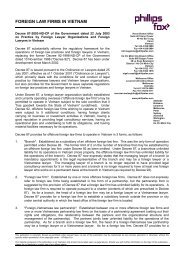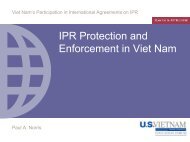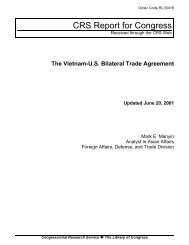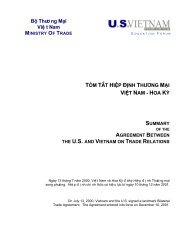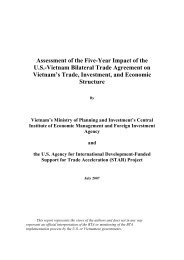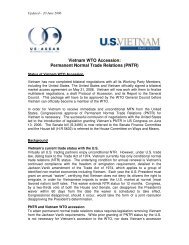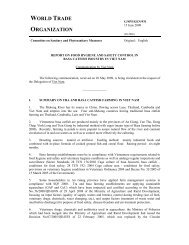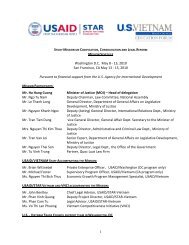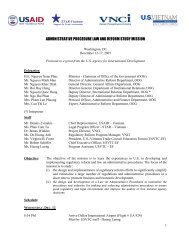Climate risks and adaptation in Asian coastal megacities: A synthesis
Climate risks and adaptation in Asian coastal megacities: A synthesis
Climate risks and adaptation in Asian coastal megacities: A synthesis
- No tags were found...
Create successful ePaper yourself
Turn your PDF publications into a flip-book with our unique Google optimized e-Paper software.
from 68 percent to 71 percent; that is, an <strong>in</strong>creaseof 7 percent <strong>and</strong> 3 percent for regular <strong>and</strong> extremeevents respectively <strong>in</strong> 2050. This is also <strong>in</strong>dicatedthrough GIS maps (Figures 3.13a <strong>and</strong> 3.13b).Figure 3.13a ■ HCMCCity Case Study:Comparison of 1-<strong>in</strong>-30-year Flood for 2008Significant <strong>in</strong>crease <strong>in</strong> both flood depth <strong>and</strong>duration for regular <strong>and</strong> extreme events <strong>in</strong>2050A key f<strong>in</strong>d<strong>in</strong>g of the hydrological analysis is thatthere is a significant <strong>in</strong>crease <strong>in</strong> both depth <strong>and</strong>duration for both regular <strong>and</strong> extreme floods overcurrent levels <strong>in</strong> 2050. The average maximum flooddepth <strong>in</strong> HCMC is about 35 cm <strong>and</strong> the averagemaximum flood duration is 64 days. As a rule ofthumb, more than 50 cm of flood water is consideredthe threshold for safe operation of vehicles<strong>and</strong> bikes. Flood duration of more than three daysat 50 cm depth is considered to cause significantdisruption <strong>in</strong> the city. Results from the hydrologicalanalysis estimate that there will be a 20 percent <strong>and</strong>43 percent <strong>in</strong>crease <strong>in</strong> average maximum depth forregular <strong>and</strong> extreme events respectively, <strong>and</strong> a 21percent <strong>and</strong> 16 percent <strong>in</strong>crease <strong>in</strong> average maximumflood duration dur<strong>in</strong>g regular <strong>and</strong> extremeevents respectively <strong>in</strong> 2050. That is, the averagemaximum flood duration <strong>in</strong>creases from 64 to 86days for regular events, <strong>and</strong> from 18–22 days forextreme events. Similar to past events, the depthof extreme floods <strong>in</strong> 2050 throughout the city willbe higher (72–100 cm) compared to the depth forregular flood<strong>in</strong>g (35–44 cm).Figure 3.13b ■ HCMCCity Case Study:Comparison of 1-<strong>in</strong>-30-year Flood for 2050 A2ScenarioIncrease <strong>in</strong> populations at risk from flood<strong>in</strong>gby regular <strong>and</strong> 1-<strong>in</strong>-30-year event <strong>in</strong> 2050Results from the hydrological model<strong>in</strong>g <strong>and</strong> GISmapp<strong>in</strong>g show that an <strong>in</strong>creas<strong>in</strong>g number <strong>and</strong>proportion of the population 44 will be affected byflood<strong>in</strong>g from regular <strong>and</strong> extreme events <strong>in</strong> 2050(Table 3.13). For regular floods, about 15 percentof HCMC’s population is affected for the basel<strong>in</strong>escenario (<strong>in</strong> 2007). This <strong>in</strong>creases to 49 percentwithout implementation of proposed flood controlmeasures. With the implementation of the proposedflood control measures, the percentage of affectedpopulation is reduced to 32 percent (ADB 2010).<strong>Climate</strong> change will also impact daily life <strong>in</strong> HCMCSource: ADB (2010).44As mentioned earlier, the official population of HCMC<strong>in</strong> 2007 was 6.4 million people <strong>and</strong> about 8 million if unregisteredmigrants are <strong>in</strong>cluded. The team considered two(high <strong>and</strong> a low) population growth scenarios, but assumeda high population growth scenario for the vulnerabilityanalysis. The high case <strong>in</strong>cludes unregistered migrants <strong>in</strong>tothe basel<strong>in</strong>e; that is, it assumes current population to beabout 8 million. This seems more realistic compared to theassumption <strong>in</strong> the low-growth scenario, which does not assumeunregistered migrants currently <strong>in</strong> the city. Further,the exist<strong>in</strong>g rate of 2.4 percent population growth assumed<strong>in</strong> the low-case scenario is low compared to the experienceof other large cities <strong>in</strong> the region.Estimat<strong>in</strong>g Flood Impacts <strong>and</strong> Vulnerabilities <strong>in</strong> Coastal Cities | 45



